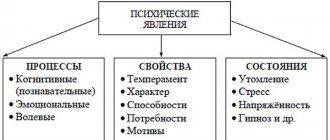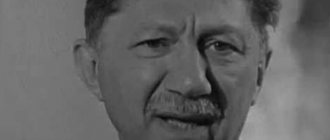What is self-awareness
What does self-awareness mean? This can be literally translated as “knowing oneself” or “knowing oneself.” The term comes from philosophy. It is no longer possible to say exactly who introduced this concept, but in psychology it is associated with the name of L.S. Vygotsky. This is what the author calls knowledge about himself: “a person’s awareness of himself as an individual, the focus of a person’s consciousness on himself: on his own body, needs, feelings, behavior.”
Let’s explain the concept of self-awareness in simple words, give a definition from psychology, and outline the main characteristics. In psychology, a person’s knowledge of himself is the subject’s awareness of himself as a separate unit, personality, participant in society and understanding of his place in the world.
What parts does a person's knowledge of himself consist of? From a person’s awareness and assessment of his thoughts, behavior, desires. It is connected with many other “itself”:
- self-esteem;
- self-esteem;
- self-worth;
- self-help;
- introspection;
- self-realization, etc.
Self-knowledge is based on a person’s acceptance of himself and awareness of his uniqueness. The search for purpose and self-determination in life, the individual’s beliefs and values, and worldview depend on this, in turn. Knowledge about oneself helps a person assess the prospects for further development in life.
Definitions of self-awareness from other sciences are practically the same:
- In social science, the definition is: “this is a person’s awareness of his actions, feelings, thoughts, motives of behavior, interests, and his position in society. And also this awareness of oneself as an individual capable of making decisions and being responsible for them.”
- In philosophy, the definition is formulated as follows: “this is a person’s awareness, assessment of his knowledge, moral character and interests, ideals and motives of behavior, a holistic assessment of himself as a feeling and thinking being, as the author of activity. This is the self-consciousness of the soul.
Let's look at the features of knowing about ourselves. A person’s perception of himself influences how the subject’s relationship with society develops. But at the same time, society influences the formation of an individual’s self-awareness.
So, how does the social conditioning of self-awareness manifest itself? Let's look at it with an example. Until the age of 6-7 years, a child has not yet developed critical thinking, so instead of self-esteem, he is guided by the assessment of adults. From their words, the child determines what he is like. If parents convince him that he is bad and unworthy, then the child grows up with such an attitude. In the future, when building relationships with society, he adheres to precisely this belief, and therefore he comes across bad people, manipulators, tyrants.
An example of self-awareness from life: a person understands that he lacks perseverance and motivation to move up the career ladder. He begins to analyze why he lacks motivation and compares his actions with the behavior patterns of successful people. As a result, he draws up a plan to develop the necessary qualities in himself and soon achieves success.
Interesting! Sometimes self-knowledge is called a person’s ability to separate and distinguish himself from everything that surrounds him.
What is “self-concept”?
So, what exactly is the “I-concept” and what psychological meaning should be given to it?
If we turn to psychological dictionaries, then “I-concept” is defined in them as a dynamic system of ideas of an individual about himself. English psychologist Robert Burns in his work “Development of Self-Concept and Education” speaks of “Self-concept” as the totality of all ideas a person has about himself, interconnected with their assessment.
“I-concept” arises in an individual during social interaction as an inevitable and always unique result of mental development, as well as as a relatively stable and, at the same time, subject to internal transformations of mental acquisition.
The initial dependence of the “I-concept” on external influences cannot be disputed, but as it develops, it begins to play an independent role in the life of all people. The surrounding reality and ideas about other people are perceived by people through the filter of “I-concept”, which is formed in the process of socialization and at the same time has specific individual biological and somatic prerequisites.
Levels
Knowledge about oneself presupposes the formation in a person of a self-concept - a stable system of ideas about oneself. It is a product of self-awareness. In the self-concept, three levels can be distinguished, they are also called levels of self-awareness:
- cognitive – a person’s ideas about himself as a person, individuality, knowledge and acceptance of all his characteristics;
- evaluative – a sense of self-worth, self-worth, including a person’s awareness of the significance and value of his profession, external features, character;
- behavioral – behavioral attitudes and a person’s attitude towards his own personality.
The emergence of the “I-concept”
As an independent concept, “I-concept” began to take shape at the turn of the 19th-20th centuries, when ideas about the dual nature of man as a subject of the knower and the known were actively discussed. Then, already in the 50s of the last century, it was developed by phenomenological and humanistic psychological science, the most prominent representatives of which were Abraham Maslow and Carl Rogers. They viewed the single human “I” as the fundamental behavioral and developmental factor. Thus, having appeared in foreign literature on psychology, in the 80s and 90s of the 20th century, the term “Self-concept” became part of domestic psychological science.
Despite this, it is quite difficult to find any precise and unified interpretation of the term in question, and the closest to it in meaning is the term “self-awareness”. The relationship between these two terms is not precisely defined today, but quite often they are considered synonyms. However, in some cases, the “I-concept” is considered separately from self-awareness, acting as a finished product of its processes.
The structure of self-awareness
What is included in the structure of self-awareness? The structure of a person’s self-awareness includes the following elements:
- Cognitive component or self-understanding. This is a person’s knowledge of himself and the development of self-images. Usually there are four: the real self (what a person is), the ideal self (what he would like and could be), the fantastic self (what he dreams of being if he had no limitations) and the mirror self (how a person is seen those around him in his opinion).
- Emotional-evaluative component or self-attitude. Acceptance or non-acceptance of oneself, confidence or uncertainty, a sense of self-worth or devaluation of oneself - all this and the like are included in this element. In general, this is a person’s emotional and evaluative attitude towards himself: self-esteem, self-respect, self-acceptance. It is formed on the basis of social norms, stereotypes, and standards. And also based on a person’s comparison of himself with other people.
- Behavioral component or self-regulation. This is the desire to fit into society, to be accepted and understood, to meet its norms, to become a respected person and a valuable unit.
- Self-actualization. This component ensures the realization and self-development of a person. Signs of healthy self-actualization of the individual: life “here and now”, doing what you love, continuous self-development, openness to new things, honesty with yourself and others, a responsible and conscious attitude towards life, self-confidence.
- Level of aspiration. This is the desire to conquer goals that are a little further than the zone of current development, that is, a little more complicated than what a person has already conquered.
According to other sources, the main components of self-awareness look like this:
- Self-knowledge (intellectual aspect). Formed through self-observation and self-assessment.
- Self-control (self-regulation). Driven by self-esteem. The more stable and adequate the self-esteem, the higher the level of self-control.
- Self improvement. Working with self-images.
The formation of a substructure is associated with the level of development of self-awareness. Let's analyze the structure through the diagram:
Note! Self-knowledge is one of the stages in the development of consciousness. And consciousness is a person’s ability to subjectively experience and interpret events in the external and internal world.
How to write a term paper on speech therapy
07.09.2010 198538
These guidelines are compiled to help students gain an understanding of the content and structure of coursework in speech therapy.
Logopedia of pedagogical science that studies anomalies of speech development with normal hearing, explores the manifestations, nature and mechanisms of speech disorders, develops the scientific basis for overcoming and preventing them means of special training and education.
The subject of speech therapy as a science is speech disorders and the process of training and education of persons with speech disorders.
The object of study is a person suffering from a speech disorder.
The main task of speech therapy as a science is the study, prevention and elimination of various types of speech disorders.
Coursework in speech therapy is a student's scientific and experimental research. This type of educational activity, provided for by the educational and professional program and curriculum, contributes to the acquisition of skills in working with literature, analyzing and summarizing literary sources in order to determine the range of insufficiently studied problems, determining the content and methods of experimental research, processing skills and qualitative analysis of the results obtained. The need to complete coursework in speech therapy is due to the updating of knowledge concerning the content, organization, principles, methods and techniques of speech therapy work.
As a rule, during their studies, students must write two term papers - theoretical and practical.
The first course work should be devoted to the analysis and synthesis of general and specialized literature on the chosen topic. Based on this analysis, it is necessary to justify and develop a method of ascertaining (diagnostic) experiment.
In the second course work, it is necessary to provide an analysis of the results obtained during the ascertaining experiment, as well as determine the directions and content of speech therapy work, and select adequate methods and techniques of correction.
So, let’s present the general requirements for the content and design of coursework in speech therapy.
The initial and most important stage of working on a course project is the choice of a topic, which is either proposed by the supervisor or chosen by the student independently from a list of topics that are consistent with the areas of scientific research of the department.
Each topic can be modified, considered in different aspects, but taking into account a theoretical and practical approach. Having chosen a topic, the student needs to think through in detail its specific content, areas of work, practical material, etc., which should be reflected both in the formulation of the topic and in the further construction of the study. It should be recalled that the chosen topic may not only have a purely theoretical orientation, for example: “Dysarthria. Characteristics of the defect”, “Classification of dysgraphia”, but also take into account the practical significance of the problem under consideration, for example: “Speech therapy work on speech correction for dysarthria”. It should also be taken into account that when formulating a topic, excessive detail should be avoided, for example: “Formation of prosodic components of speech in preschoolers of the sixth year of life attending a preschool institution for children with severe speech impairments.”
The course work includes such mandatory parts as: introduction, three chapters, conclusion, bibliography and appendix.
The text of the term paper begins with the title page . An example of its design can be seen here.
Then the content of the work is given, in which the names of chapters, paragraphs, and sections are formulated in strict accordance with the content of the thesis. An example of its design can be seen here.
In the text, each subsequent chapter and paragraph begins on a new page. At the end of each chapter, the materials are summarized and conclusions are formulated.
The introduction reveals the relevance of the problem under consideration in general and the topic being studied in particular; the problem, subject, object, and purpose of the study are defined. In accordance with the goal and hypothesis, objectives and a set of research methods aimed at achieving the objectives must be defined.
The relevance of the topic lies in reflecting the current level of pedagogical science and practice, meeting the requirements of novelty and usefulness.
When defining the research problem, it is important to indicate what practical tasks it will help to implement in training and educating people with speech pathology.
The object of research is understood as certain aspects of pedagogical reality, perceived through a system of theoretical and practical knowledge. The ultimate goal of any research is to improve this object.
The subject of research is some part, property, element of an object, i.e. the subject of research always indicates a specific aspect of the object that is to be studied and about which the researcher wants to gain new knowledge. An object is a part of an object.
You can give an example of the formulation of the object, subject and problem of research:
– The object of the study is the speech activity of preschool children with phonetic-phonemic speech disorders.
– The subject of the study is the features of intonation speech of children with phonetic-phonemic speech disorders.
– The research problem is to determine effective directions for speech therapy work on the formation of intonation expressiveness of speech in the system of correctional intervention.
The purpose of the study contributes to the specification of the object being studied. The goal of any research is to solve a specific problem. The goal is specified in tasks taking into account the subject of research.
The research objectives are formulated in a certain sequence, which determines the logic of the research. The research objectives are set on the basis of a theoretical analysis of the problem and an assessment of the state of its solution in practice.
The first chapter is an analysis of literary sources, which examines the state of this problem in historical and modern aspects, and presents the most important theoretical principles that formed the basis of the study.
When writing the first chapter, you should pay attention to the fact that the text of the course work must be written in a scientific style. When presenting scientific material, it is necessary to comply with the following requirements:
– Specificity – a review of only those sources that are necessary to disclose only a given topic or solve only a given problem;
– Clarity – which is characterized by semantic coherence and integrity of individual parts of the text;
– Logicality – which provides for a certain structure of presentation of the material;
– Reasoning – evidence of thoughts (why this and not otherwise);
– Precision of wording, excluding ambiguous interpretation of the authors’ statements.
A literary review of the state of the problem being studied should not be reduced to a consistent presentation of literary sources. It should present a generalized description of the literature: highlight the main directions (currents, concepts, points of view), analyze in detail and evaluate the most fundamental works of representatives of these directions.
When writing a work, the student must correctly use literary materials, make references to the authors and sources from which the results of scientific research are borrowed. Failure to provide required references will reduce your coursework grade.
As a rule, in coursework on speech therapy, references to literary sources are formatted as follows: the number of the cited source in the general list of references is placed in square brackets. For example: General speech underdevelopment is a speech pathology in which there is a persistent lag in the formation of all components of the language system: phonetics, vocabulary and grammar [17].
When using quotations, in square brackets, in addition to indicating the source number, the page number from which this excerpt is taken is indicated, for example: Speech rhythm is based on a physiological and intellectual basis, since, firstly, it is directly related to the rhythm of breathing. Secondly, being an element that performs a communicative function, “correlates with meaning, i.e. controlled intellectually” [23, P.40].
However, course work should not be of a purely abstract nature, so you should not abuse the unreasonable abundance of citations. Quoting should be logically justified, convincing and used only when really necessary.
In the second chapter , devoted to experimental research, the organization should be described and the program of the ascertaining experiment should be presented. The survey methodology, as a rule, consists of a description of several series of tasks, with detailed instructions, visual and lexical material, the procedure for completing tasks by experiment participants, and scoring criteria. This chapter also provides a qualitative and quantitative analysis of the results obtained.
When analyzing the results of an experiment, it is necessary to use a scoring system. Examples of various criteria for quantitative and qualitative assessment are presented in the following works:
– Glukhov V.P. Formation of coherent speech in preschool children with general speech underdevelopment. - M.: Arkti, 2002. - 144 p.
– Fotekova T.A. Test methodology for diagnosing oral speech of primary schoolchildren. - M.: Arkti, 2000. - 56 p.
– Levchenko I.Yu. Pathopsychology: Theory and practice. - M.: Academy, 2000. - 232 p.
In order to visually present the results obtained during the experimental study, it is recommended to use tables, graphs, diagrams, etc. Histograms can be used in a variety of ways - columnar, cylindrical, planar, volumetric, etc. An example of the design of tables, figures, and histograms can be found here.
The third chapter provides a rationale for the proposed methods and techniques and reveals the content of the main stages of correctional work.
The conclusion contains a summary of the material presented and the main conclusions formulated by the author.
The bibliography must contain at least 25 sources. The list includes bibliographic information about the sources used in preparing the work. An example of its design can be seen here.
In the application you can present bulky tables or illustrations, examination protocols, observation records, products of activity (drawings, written works of children), notes from speech therapy classes, etc.
The volume of one course work must be at least 30 pages of typewritten text.
In general, coursework in speech therapy is the basis for a future thesis, in which the study of the begun problem can be continued, but from the standpoint of a different approach or a comparative analysis of the disorders being studied in different age categories of people with different types of speech disorders.
The content and format of theses in speech therapy can be found here.
Literature:
1. How to write a term paper on speech therapy: Methodological recommendations. Educational and methodological manual / Comp. Artemova E.E., Tishina L.A. / Ed. Orlova O.S. – M.: MGOPU, 2008. – 35 p.
2. Research work of students in the system of higher professional pedagogical education (specialty 031800 - Speech therapy). Methodological recommendations for completing the thesis / Compiled by. L.V. Lopatina, V.I. Lipakova, G.G. Golubeva. - St. Petersburg: Publishing house of the Russian State Pedagogical University named after. A. I. Herzen, 2002. - 140 p.
Functions of self-awareness
What functions and roles does a person’s knowledge about himself perform? In psychology, it is customary to distinguish the following functions of self-awareness:
- Function of development and self-improvement. The need for self-realization pushes the individual onto the path of positive changes, the transformation of the ideal self into the real self.
- Existential function. Self-awareness helps a person find meaning and purpose in life.
- Regulatory function. On the basis of his self-awareness, a person builds relationships with society, regulates and organizes his behavior and activities.
- Integrative function. A person seeks a balance between personal and social, internal and external world.
- Protective function. Despite the desire for positive changes, a person at the same time struggles to maintain his usual self-image. In life, this looks, for example, like defending personal boundaries.
Forms
Personal knowledge about oneself is a person’s system of ideas about himself, his mental and physical states. There are several forms of self-awareness.
According to the typology of V.V. Mironov forms of self-awareness are:
- Well-being. This is a person’s awareness of his body and its place, participation in the world.
- Self-identification. A person's identification with a social or cultural group.
- Personal knowledge about yourself. A person recognizes himself as someone similar to other people, but at the same time different from them. Along with this comes awareness of freedom of action and responsibility for them. Against this background, self-control and self-esteem come into play.
Sometimes these forms are called levels of human self-awareness. The first form is the lowest level, the third is the highest.
In addition to forms, it is customary in psychology to distinguish types or types of self-awareness:
- Public or social. This is a complex of collective beliefs and ideas about society during a certain period of time.
- Private. This is a person's awareness of certain aspects of himself. For example, when a subject looks in a mirror and sees his own face.
- Moral. This is a system of moral images and ideals to which a person strives.
All types are closely related to each other.
Forms and levels of human self-awareness
Self-awareness manifests itself in four forms, let's look at each of them.
Self-knowledge
This concept means identifying oneself among other people and the world around us, recognizing personal qualities, the physical body, and potential.
Self-awareness comes through:
- Self-observation of the results of one’s activities, the results of communication with the environment and analysis of the compliance of the results with accepted standards.
- Understanding the assessments of other people about their personality and actions, their attitudes.
- Analysis of your feelings, emotions and needs, and their transformations.
The result of self-knowledge is the formation of a system of ideas about oneself.
Self-control
A person has the opportunity, after analyzing his essence and behavior, to correct them. Any actions and psychological states can be changed if, in the opinion of the person himself, they contradict his attitudes, do not give the desired results, or come into conflict with the outside world.
Self-esteem
Self-esteem expresses the degree to which a person accepts his qualities, characteristics and characteristics. The perception itself reveals the level of love and respect for oneself.
Adequate self-esteem characterizes a self-confident person, capable of making decisions and purposeful actions. When low, we see a person dependent on the opinions of others, with a pronounced sense of guilt and a lot of complexes. An overestimation of personal qualities reveals a person who is self-confident, arrogant, and does not accept any criticism.
To achieve life goals, self-esteem should be developed to a normal level; in psychology there are many exercises to increase the degree of self-love.
Self-acceptance
This form of self-awareness involves:
- Accepting yourself as a unique individual, without unjustified criticism and self-deprecation.
- Self-respect.
Self-esteem comes from achieving goals and satisfying aspirations. A person sets records in sports, quits smoking, finishes writing a novel - his self-esteem increases, which has a good effect on self-esteem.
In addition to forms, psychology considers 4 levels of self-perception:
- Sensual
. This is the lowest level at which one’s psychological characteristics, experiences, and physiological processes are understood. This is the stage of self-identification. - Figurative and personal
. Gives recognition of oneself as a subject of active activity. Self-actualization occurs, maintaining the identity of “I”. - Analytical (otherwise reflexive)
. A person analyzes and clarifies his thoughts and actions, observes the manifestation of emotions in critical states, analyzes committed mistakes and failures, and draws conclusions. - Active
. Based on the results and experience of the first three stages, self-regulation, motivation, correction of behavioral structures and self-control occur. This is a stage of personal change based on self-knowledge.
Going through all four levels of self-awareness indicates the maturity of the individual; getting stuck on one of them requires further development.
How self-awareness is formed
The problem of self-awareness is complex. In psychology, it is considered from different angles. For example, they study the development of knowledge about oneself in accordance with age-related changes in a person.
How self-awareness is formed as a person grows up (stages of development of knowledge about oneself):
- From 0 to 1 year. A rudimentary knowledge of oneself arises. The child understands that he exists. The first level of development of self-awareness is characterized by awareness of biological needs: food, water, care.
- From 2 to 3 years. Allopsychic knowledge about oneself. The child begins to see himself as an independent person, to separate his actions from the actions of other people.
- From 4 to 7 years. Self-psychic knowledge about oneself is formed, that is, the child can already evaluate, understand and recognize his physical states, emotions, and feelings.
- From 8 to 17 years. The formation of self-awareness ends. The young man develops a stable system of ideas about himself.
In the future, knowledge about oneself is not formed, but modified. Thus, a person’s self-awareness mainly develops by the age of 17.
What influences the formation of self-awareness? The formation of knowledge about oneself is influenced by the significant environment, society as a whole, the assessment of the subject by other people, status in the peer group, a person’s assessment of himself, the ratio of the images of the real self and the ideal self.
Here are the prerequisites for the formation of self-awareness:
- a person’s awareness of his similarity with other people;
- consciousness of one's Self as an active principle;
- a person’s consciousness of his mental properties and qualities;
- formation of a system of social and moral attitudes.
L.S. Vygotsky believed that the development of the structure of self-consciousness occurs according to a pattern close to the development of higher mental functions.
Personal self-awareness in psychology
The concept of self-awareness is so complex and multifaceted that in psychology there is still no single concept of its understanding. Synonyms for the word are: “I am a self,” “I am a concept,” “self-identity.”
The basics of the concept were formulated by S.L. Rubinstein, who pointed out the possibility of self-awareness to understand oneself, the personal environment and the existing structure of relationships with people.
According to S.V. Vygotsky, self-consciousness is formed in a person by the end of adolescence. He connects this process with the ability to reflect (think, ponder), which is formed by the age of seven.
According to the theory of V.S. Merlin's understanding of himself consists of the following components:
- Distinctive features from other subjects and objects.
- Understanding your own emotions, having self-esteem.
- Awareness of oneself as a subject of activity.
Psychologists have identified the following criteria for self-awareness:
- Isolation of the individual from the environment (material and social).
- Understanding the ability to control oneself – actions and thoughts.
- Trying on the visible qualities of other people.
- The ability to see your needs and the deep motives of your actions.
- Awareness of one’s own character traits and personality traits, both existing and desired.
In addition, within the framework of self-awareness in psychology, such a factor as attitude towards other people is highlighted; it can also be different.
The egocentric layer assumes that the individual forms an attitude towards others in accordance with their attitude towards themselves. That is, if they love me, then I love, if they respect me, then I will respect.
The group-centric stage of relationships is based on the principle: “If a person belongs to a certain group, then he is correct.” It is assumed that the person himself belongs to this same group.
A prosocial approach ensures understanding of the value of any person and acceptance of him with all his shortcomings.
At the highest, estoholic level, other people are considered as part of the spiritual world, humanity and patience are positioned in relation to any individual.
Developing Self Awareness
The development of human self-awareness begins at birth and continues throughout life. Let us briefly present the plan for the development of self-awareness:
- the child’s awareness of the very fact of his existence (at the physical level through sensations, awareness of himself in his physical body);
- the child’s separation of himself from the surrounding world and society;
- the child’s awareness of his emotions, feelings and desires;
- development of self-esteem (evaluation of actions, behavior, personal qualities);
- the ability to determine mental states, recognize feelings and motives;
- awareness of advantages and disadvantages and other individual characteristics, development of images of the real Self and the ideal Self;
- the formation of a sense of self-worth that does not depend on external circumstances.











